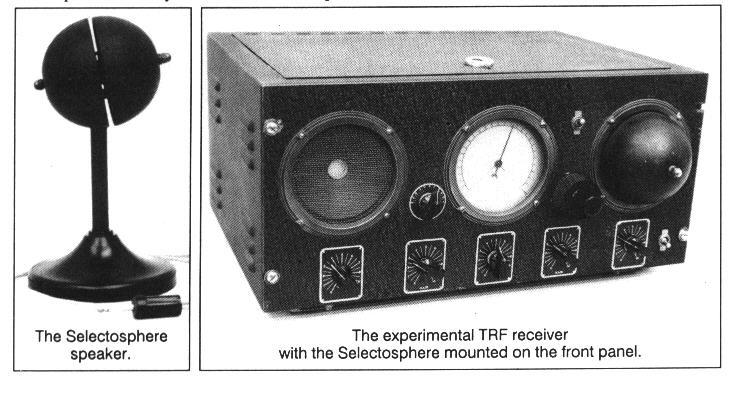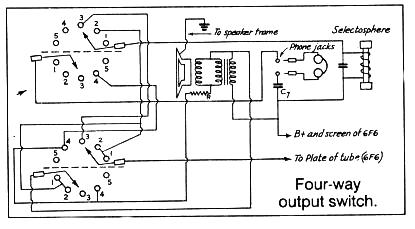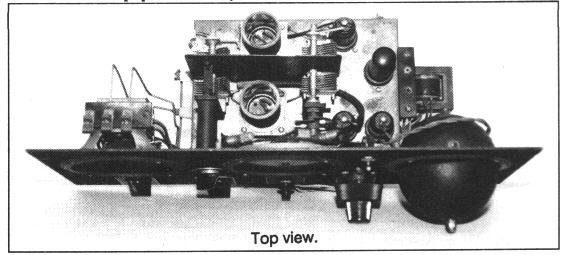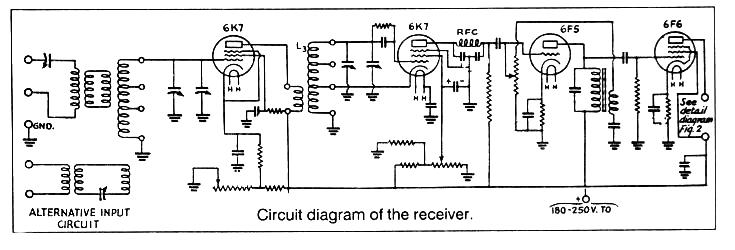 |
|
|
|
|
| This
unusual-looking piece of equipment is, in fact, a TRF communications receiver,
vintage 1938. What sets it apart from the usual of that era is the protruding
globe on the front panel, a highly selective loudspeaker. This device,
the 'Selectosphere," gave the receiver high selectivity without a
crystal filter.
Unfortunately, an attempt to market the device fell far short of success. Poorly understood by the amateur fraternity and in the face of strong competition, the effort was too little and too late. Consequently, this device is very rare. It is hoped that enough collectors will now recognize a Selectosphere to save a few from the landfill Two persons are to be commended: the author for his enterprise and interest in acquiring the receiver, and WA3WHR for correctly identifying it. We are looking forward to a performance report when it is restored. - K3ZJW |
manufacturers adopted the IF crystal filter for their 'top
of the line' receivers. Audio selectivity techniques were also investigated
for TRF and regenerative receivers, where a crystal filter could not be
used. These designs used LC filters, audio regeneration, or acoustically
resonant speakers. Resonant speakers were sold by El-Me-Ac and Meissner,
but probably the most unusual was the Selectosphere.
The Selectosphere first appeared in the amateur literature via an article by Malcolm Gager (of the Department of Physics at Boston College) in Radio [1]. This device, pictured below, used a magnetostrictive driver assembly located inside the hollow steel hemispheres. The driver was electrically resonant at 1000 Hz, the hemispheres were mechanically tuned to the same frequency, and the volume of air in the sphere was acoustically resonant at 1000 Hz. This triple resonance resulted in a highly selective speaker having a bandwidth of approximately 30 Hz. As a bonus, it also exhibited acoustical output limiting at a comfortable listening level. This first article presented the theory and characteristics of the device, and promised a second 'applications' article. The latter, which appeared in QST [2], described the four-tube TRF receiver shown in the photos. |
| The 1930s was a period of rapid development in amateur receivers. The superheterodyne became the receiver of choice and designers were struggling with new demands for improved sensitivity, selectivity and stability. Single-signal reception was now a reality, and all the leading | |

|
|
 |
|
| Its design was loosely based on the TRF "Autodyne" receiver
in the 1938 ARRL Handbook, and consisted of an RF stage and regenerative
detector followed by two stages of audio amplification, all with metal
tubes.
The unusual speaker system consisted of the Selectosphere paired with a conventional unit, with a selector switch giving the operator four options: the conventional speaker, the Selectosphere, the two together, or headphones. Audio regeneration was provided in the first audio stage for additional selectivity. The Selectosphere was mounted directly on the front panel, and the receiver featured rugged construction to minimize microphonic effects. An additional tuning vernier was required to slow the tuning rate when the Selectosphere was used. The Selectosphere Company of Newtonville, MA ran six small ads in QST during 1938. Originally offered at $7.50 plus shipping, it was reduced to $3.95 at midyear. Unfortunately, audio selectivity in any of its forms never became popular in amateur receivers, and the Selectosphere was not a commercial success. It was, after all, a mechanical solution in an electrical hobby, and CW operators generally preferred a lower beat note and the use of headphones. The unit shown is the actual receiver built and photographed for the 1938 QST article. I purchased it at the 1991 spring hamfest in Timonium, MD. I had looked at it on Saturday but thought it was some type of lab instrument. |
It was still for sale on Sunday, and a closer look revealed four sets
of National SW-3 type coil forms, so I bought it for parts. Fortunately,
fellow collector Dave Burns, WA3WHR, saw it at my shop and identified the
metal sphere as an acoustic resonator. He thought that a similar receiver
had been described around 1938 in QST. Some quick research showed he was
correct and that this was the original Gager receiver. Serendipity saves
another interesting artifact from the scrap pile!
The receiver is in excellent physical condition and will be restored to operating status in the near future. Malcoira Gager (1904-1977), the apparent inventor of the Selectosphere, had published a couple of papers on dynatron oscillators in the IRE Proceedings in the mid-Thirties but was best known for his later work in over-the-horizon radar while head of the Radar Techniques Branch of the Naval Research Laboratory. REFERENCES 1. F. Malcolm Gager, "Audio Selectivity with the Selectosphere," Radio, October 1936, pp. 28-31. 2. F. Malcolm Gager and Arthur F. Graham, "A Regenerative Receiver with High Audio Selectivity," QST, February 1938, pp. 16-18. Photographs: John Kelly
N3GVF |
 |
|
